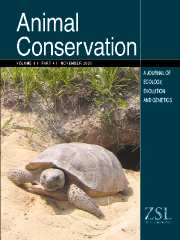Article contents
Microhabitat use by a translocated population of St Lucia whiptail lizards (Cnemidophorus vanzoi)
Published online by Cambridge University Press: 18 May 2001
Abstract
Microhabitat use studies of translocated species are crucial to assess their adaptation to the new environment. A total of 42 St Lucia whiptail lizards (Cnemidophorus vanzoi), an endemic to two islets (Maria Major, 10.2 ha and Maria Minor, 1.8 ha) off St Lucia in the Lesser Antilles, were translocated from Maria Major to Praslin Island (1.1 ha) in 1995. Three years after the release, we studied the abundance, density and distribution of the translocated lizard population in the prevailing five habitat types on the island. Habitats varied from more exposed open grasslands to tall, continuously canopied woodlands. Although lizards were distributed throughout the island, some habitats were used more than predicted with respect to availability. Habitat utilization showed a seasonal shift in distribution. Line transect sampling estimated a population of 145 ± 23 lizards on Praslin Island. There were significant seasonal differences in estimated lizard abundance indicating a change in activity during the dry season. Lizard density was significantly correlated with general habitat characteristics, rather than with any specific microhabitat variable measured. Factors affecting distribution (thermo-regulation, food resources and competitive exclusion) are discussed and it is suggested that habitat use during the dry season may be best explained by thermal constraint. These results will help managers choose future translocation sites.
- Type
- Research Article
- Information
- Copyright
- © 2001 The Zoological Society of London
- 4
- Cited by


